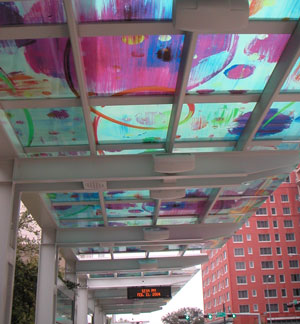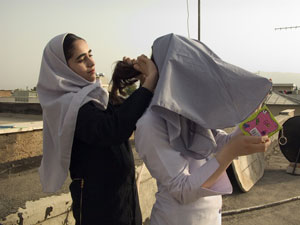In her current show at Women and Their Work, Soody Sharifi collaborates with her son Payam to expand her photographic investigation of the contrasts of public and private that characterize contemporary life in Iran.

Soody Sharifi ... The Martyrs... 2005... Installation wall view... Various sizes of printed digital images with adhesive backing
The composite views of the Tehran cityscape which open the show are an abrupt shift away from the intimate moments that otherwise dominate Sharifi’s work. The artist has covered a large, L-shaped wall with oversized photographs of residential high-rises, cropped so that the surface of the wall stands in for the urban sky. The buildings in each photograph are covered on at least one side with heroic, monumental murals of Iranian leaders and martyrs, soldiers who fell in the Iran-Iraq war and other, more recent conflicts. As Sharifi’s son Payam notes in an essay elsewhere in the show, the style of these paintings is derived from Soviet-style Socialist Realist painting. They are reminders of Soviet political influence in the region in the 1980s, but the Iranian paintings differ from their Soviet models in that they aren’t depictions of generic heroes, but instead detailed portraits of specific individuals.
Sharifi’s method of splicing multiple photographs together results in a skyline with a slightly wobbly, shifting perspective, rather than a flawless panorama with consistent vanishing points. While this instability reveals the breaks between the pictures and highlights the artificiality of the image, the effect is very restrained; and on first glance, the edges between the individual photos aren’t so easy to see. It’s an eerie but plausible vista. In Iranian cities, these murals are spread across the city. In the gallery hallway, though, they are squeezed together; on either side, colossal faces that are alternately fierce, gloomy, and pensive bear down on the viewer. I found myself thinking about surveillance. While these images may not surveil, they do proscribe. Like all such propaganda, the Iranian murals create a cohesive, official public face for the country, communicating a visual message which in turn acts as a moral compass for the population describing whom to respect, whom to obey, whom to emulate. Whether or not anyone follows the visual dictates of these murals is another matter.
The authoritarian public face of the city stands in sharp contrast to the private aspects of Iranian life depicted in the rest of the Sharifis’ photographs. The current show includes examples from Sharifi’s two series, Teenagers and Maxiatures, both of which observe and meditate on the details of life lived between western popular culture and Islamic society.
In the Teenagers pictures there is an implication of universality: kids everywhere are just kids. Oh, Enrique catches two young women hanging out in a bedroom. One, shoeless but veiled, lounges on the bed with a magazine while the other, her hair unbound, lies on the floor mooning over a poster of Enrique Iglesias. This image suggests a comfortable private sphere in which these two young women exist completely at ease. The curtain over the large window which allows light into the space keeps the girls from public view; but the picture hints that every girl needs a similarly cozy, protected space.
In Hair, the scene is outdoors, but the intimacy remains. Sharifi shows two girls standing together in profile, one holding a small book. Her eyes are obscured by her veil, which is flipped forward and covers her face so that her companion can pull her hair into a ponytail. If Enrique appears to document the importance of privacy (and the teenage celebrity crush), this picture records the development of trust — letting a friend touch your hair can be a big deal, after all — and self image through the girls’ shared grooming, another preoccupation of adolescence.
As is the case with the cityscape, it’s important to point out the artificiality of these images. Although they look like spontaneous, intimate and revealing snapshots, the pictures are composed; the photographer gives her subjects props to use at their discretion, and the subjects also decide what poses to take. Each picture is shaped by its subjects, who consciously manifest adolescent self-image.1.
Where the Teenagers works highlight the contrasts and affinities of youth culture in East and West, Sharifi’s Maxiatures synthesize contemporary and traditional Iranian culture. They do so in a very literal way, by incorporating photographs of Iranian teenagers into reproductions of courtly Persian miniatures. On one hand, this project is fairly banal: take a medieval topic, say, romance in the royal apartments, and insert modern youth using the magic of Photoshop. But these visually striking pictures aren’t simply gimmicky. In Courtly Love, modern teenage girls frolic inside and around a three-story palace (two adjust the satellite dish on the roof). Games of childhood, like jumping rope and hula-hooping, exist within the same space as tentative interactions with boys. Sharifi’s montages are meditations on the intersection of childhood and adulthood, but also on Iran’s artistic heritage and its place within modern Iranian culture.
If Soody Sharifi’s photographs aim to demonstrate how familiar the lives of these girls might be to a western viewer, her son Payam Sharifi’s observations of Iranian culture emphasize the undeniable differences between Iranian and western society. His impressions of Iran, made during his first visit to the country, are recorded in a collection of brief essays that zero in on details that aren’t necessarily ideological or religious. He considers the use of fluorescent light bulbs as design elements in public spaces and the importance of the eyes and eyebrows as standards of beauty for women and men. And Sharifi notes his own position outside of a culture to which he has a deep personal connection; entering the country, for example, he is forced to think about what whether his dress might be considered indecent. With a little irony, his little series of photos of public art, primarily iconic sculptures of animals like love birds, horses, and lions, draws attention to an ongoing debate over what the language of public representation can be in a conservative Islamic society. (The political murals photographed by his mother, in the meantime, are about as mimetic as it gets.)
Snapshots from Payam Sharifi’s visit to Iran are interspersed throughout the gallery with his mother’s posed photographs, and the artists were purposefully vague about whose work was whose in this installation. I found this arrangement frustrating visually, I think because it prevented the two very different projects, Payam’s documentation of Iranian culture and Soody’s manipulated interrogations of it, from functioning effectively on their own. The photographs are mounted at different heights and in scattered shapes that are meant to recall elements traditionally used in Iranian architecture, but for the uninformed viewer this imitation of motifs is hard to detect. Practically speaking, it diminishes the impact of some of the work. For example, 7:42 pm, one of Sharifi’s most arresting compositions, is placed high up in a corner so that a miniscule but crucial detail, a tiny reflection of the setting sun, gets lost.
The show thrives on contrasts. On the surface, East faces West and tradition vies with contemporaneity, but it’s the deeper frictions between private life and the urban experience, especially Soody Sharifi’s poetic depictions of intimate moments within public space, that are really compelling.
1.See Soody Sharifi, “Simply Girls – Teenagers in Iran,” artist’s statement. Exhibition at The Center for Photography at Woodstock, September 4 – October 24, 2004.
Heather Mathews is an art historian living in Austin.






